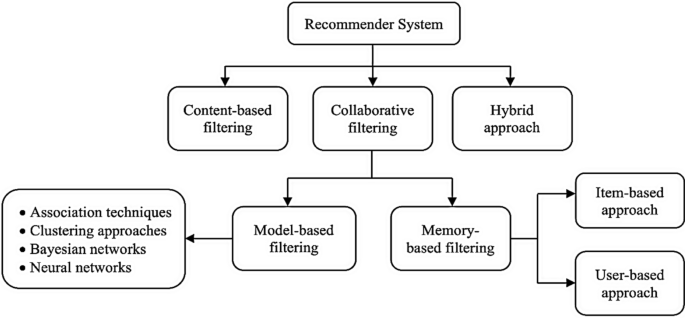
Recommender systems are efficient tools for filtering online information, which is widespread owing to the changing habits of computer users, personalization trends, and emerging access to the internet. Even though the recent recommender systems are eminent in giving precise recommendations, they suffer from various limitations and challenges like scalability, cold-start, sparsity, etc. Due to the existence of various techniques, the selection of techniques becomes a complex work while building application-focused recommender systems. In addition, each technique comes with its own set of features, advantages and disadvantages which raises even more questions, which should be addressed. This paper aims to undergo a systematic review on various recent contributions in the domain of recommender systems, focusing on diverse applications like books, movies, products, etc. Initially, the various applications of each recommender system are analysed. Then, the algorithmic analysis on various recommender systems is performed and a taxonomy is framed that accounts for various components required for developing an effective recommender system. In addition, the datasets gathered, simulation platform, and performance metrics focused on each contribution are evaluated and noted. Finally, this review provides a much-needed overview of the current state of research in this field and points out the existing gaps and challenges to help posterity in developing an efficient recommender system.
The recent advancements in technology along with the prevalence of online services has offered more abilities for accessing a huge amount of online information in a faster manner. Users can post reviews, comments, and ratings for various types of services and products available online. However, the recent advancements in pervasive computing have resulted in an online data overload problem. This data overload complicates the process of finding relevant and useful content over the internet. The recent establishment of several procedures having lower computational requirements can however guide users to the relevant content in a much easy and fast manner. Because of this, the development of recommender systems has recently gained significant attention. In general, recommender systems act as information filtering tools, offering users suitable and personalized content or information. Recommender systems primarily aim to reduce the user’s effort and time required for searching relevant information over the internet.
Nowadays, recommender systems are being increasingly used for a large number of applications such as web [1, 67, 70], books [2], e-learning [4, 16, 61], tourism [5, 8, 78], movies [66], music [79], e-commerce, news, specialized research resources [65], television programs [72, 81], etc. It is therefore important to build high-quality and exclusive recommender systems for providing personalized recommendations to the users in various applications. Despite the various advances in recommender systems, the present generation of recommender systems requires further improvements to provide more efficient recommendations applicable to a broader range of applications. More investigation of the existing latest works on recommender systems is required which focus on diverse applications.
There is hardly any review paper that has categorically synthesized and reviewed the literature of all the classification fields and application domains of recommender systems. The few existing literature reviews in the field cover just a fraction of the articles or focus only on selected aspects such as system evaluation. Thus, they do not provide an overview of the application field, algorithmic categorization, or identify the most promising approaches. Also, review papers often neglect to analyze the dataset description and the simulation platforms used. This paper aims to fulfil this significant gap by reviewing and comparing existing articles on recommender systems based on a defined classification framework, their algorithmic categorization, simulation platforms used, applications focused, their features and challenges, dataset description and system performance. Finally, we provide researchers and practitioners with insight into the most promising directions for further investigation in the field of recommender systems under various applications.
In essence, recommender systems deal with two entities—users and items, where each user gives a rating (or preference value) to an item (or product). User ratings are generally collected by using implicit or explicit methods. Implicit ratings are collected indirectly from the user through the user’s interaction with the items. Explicit ratings, on the other hand, are given directly by the user by picking a value on some finite scale of points or labelled interval values. For example, a website may obtain implicit ratings for different items based on clickstream data or from the amount of time a user spends on a webpage and so on. Most recommender systems gather user ratings through both explicit and implicit methods. These feedbacks or ratings provided by the user are arranged in a user-item matrix called the utility matrix as presented in Table 1.

In content-based recommender systems, all the data items are collected into different item profiles based on their description or features. For example, in the case of a book, the features will be author, publisher, etc. In the case of a movie, the features will be the movie director, actor, etc. When a user gives a positive rating to an item, then the other items present in that item profile are aggregated together to build a user profile. This user profile combines all the item profiles, whose items are rated positively by the user. Items present in this user profile are then recommended to the user, as shown in Fig. 2.
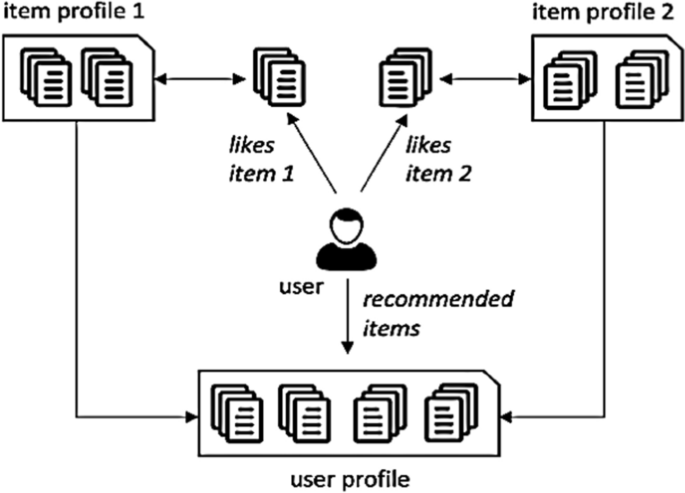
One drawback of this approach is that it demands in-depth knowledge of the item features for an accurate recommendation. This knowledge or information may not be always available for all items. Also, this approach has limited capacity to expand on the users' existing choices or interests. However, this approach has many advantages. As user preferences tend to change with time, this approach has the quick capability of dynamically adapting itself to the changing user preferences. Since one user profile is specific only to that user, this algorithm does not require the profile details of any other users because they provide no influence in the recommendation process. This ensures the security and privacy of user data. If new items have sufficient description, content-based techniques can overcome the cold-start problem i.e., this technique can recommend an item even when that item has not been previously rated by any user. Content-based filtering approaches are more common in systems like personalized news recommender systems, publications, web pages recommender systems, etc.
Collaborative approaches make use of the measure of similarity between users. This technique starts with finding a group or collection of user X whose preferences, likes, and dislikes are similar to that of user A. X is called the neighbourhood of A. The new items which are liked by most of the users in X are then recommended to user A. The efficiency of a collaborative algorithm depends on how accurately the algorithm can find the neighbourhood of the target user. Traditionally collaborative filtering-based systems suffer from the cold-start problem and privacy concerns as there is a need to share user data. However, collaborative filtering approaches do not require any knowledge of item features for generating a recommendation. Also, this approach can help to expand on the user’s existing interests by discovering new items. Collaborative approaches are again divided into two types: memory-based approaches and model-based approaches.
Memory-based collaborative approaches recommend new items by taking into consideration the preferences of its neighbourhood. They make use of the utility matrix directly for prediction. In this approach, the first step is to build a model. The model is equal to a function that takes the utility matrix as input.
Model = f (utility matrix)
Then recommendations are made based on a function that takes the model and user profile as input. Here we can make recommendations only to users whose user profile belongs to the utility matrix. Therefore, to make recommendations for a new user, the user profile must be added to the utility matrix, and the similarity matrix should be recomputed, which makes this technique computation heavy.
Recommendation = f (defined model, user profile)
where user profile ∈ utility matrix
Memory-based collaborative approaches are again sub-divided into two types: user-based collaborative filtering and item-based collaborative filtering. In the user-based approach, the user rating of a new item is calculated by finding other users from the user neighbourhood who has previously rated that same item. If a new item receives positive ratings from the user neighbourhood, the new item is recommended to the user. Figure 3 depicts the user-based filtering approach.
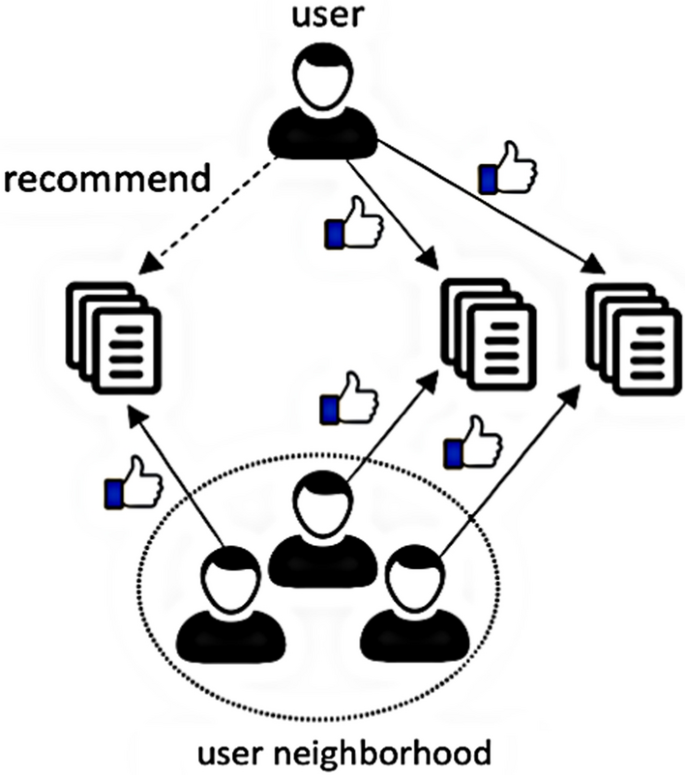
In the item-based approach, an item-neighbourhood is built consisting of all similar items which the user has rated previously. Then that user’s rating for a different new item is predicted by calculating the weighted average of all ratings present in a similar item-neighbourhood as shown in Fig. 4.
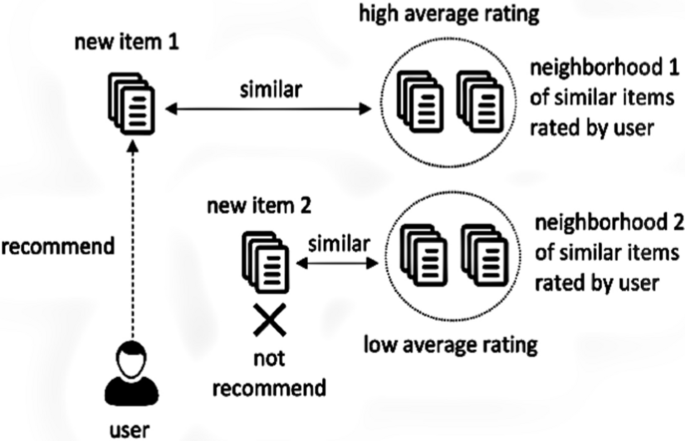
Model-based systems use various data mining and machine learning algorithms to develop a model for predicting the user’s rating for an unrated item. They do not rely on the complete dataset when recommendations are computed but extract features from the dataset to compute a model. Hence the name, model-based technique. These techniques also need two steps for prediction—the first step is to build the model, and the second step is to predict ratings using a function (f) which takes the model defined in the first step and the user profile as input.
Recommendation = f (defined model, user profile)
where user profile ∉ utility matrix
Model-based techniques do not require adding the user profile of a new user into the utility matrix before making predictions. We can make recommendations even to users that are not present in the model. Model-based systems are more efficient for group recommendations. They can quickly recommend a group of items by using the pre-trained model. The accuracy of this technique largely relies on the efficiency of the underlying learning algorithm used to create the model. Model-based techniques are capable of solving some traditional problems of recommender systems such as sparsity and scalability by employing dimensionality reduction techniques [86] and model learning techniques.
A hybrid technique is an aggregation of two or more techniques employed together for addressing the limitations of individual recommender techniques. The incorporation of different techniques can be performed in various ways. A hybrid algorithm may incorporate the results achieved from separate techniques, or it can use content-based filtering in a collaborative method or use a collaborative filtering technique in a content-based method. This hybrid incorporation of different techniques generally results in increased performance and increased accuracy in many recommender applications. Some of the hybridization approaches are meta-level, feature-augmentation, feature-combination, mixed hybridization, cascade hybridization, switching hybridization and weighted hybridization [86]. Table 2 describes these approaches.
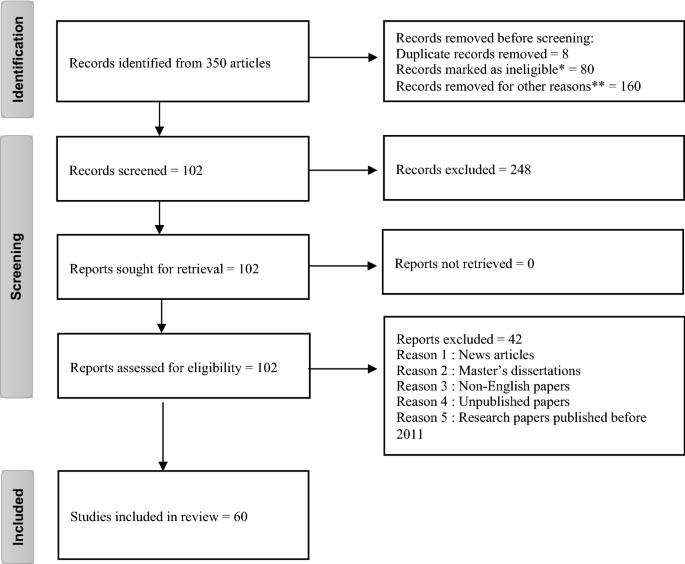
Each paper was carefully reviewed and classified into 6 categories in the application fields and 3 categories in the techniques used to develop the system. The classification framework is presented in Fig. 6.
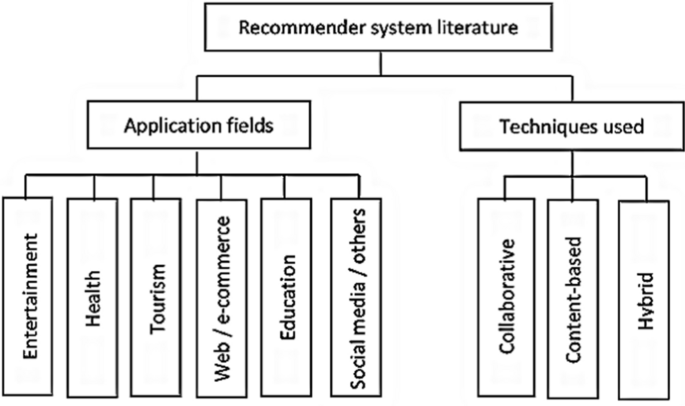
The number of relevant articles come from Expert Systems with Applications (23%), followed by IEEE (17%), Knowledge-Based System (17%) and Others (43%). Table 3 depicts the article distribution by journal title and Table 4 depicts the sector-wise article distribution.
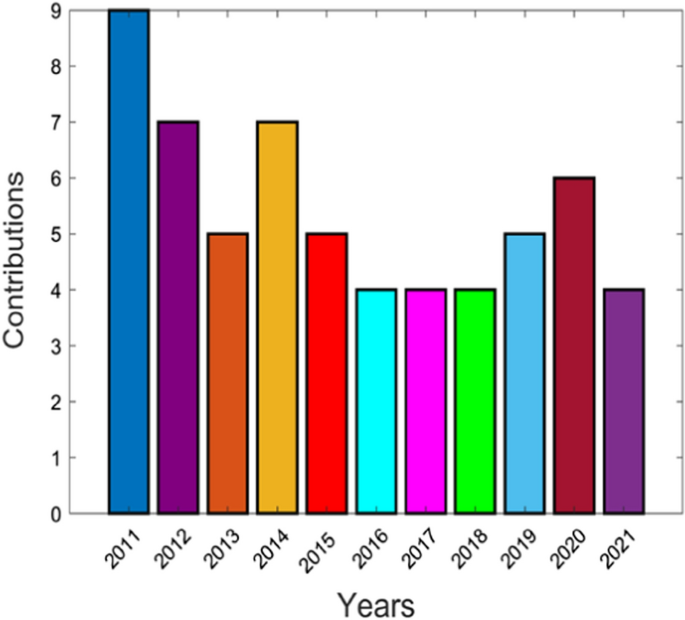
This review puts forward a comparison of the number of research works proposed in the domain of recommender systems from the year 2011 to 2021 using various deep learning and machine learning-based approaches. Research articles are categorized based on the recommender system classification framework as shown in Table 5. The articles are ordered according to their year of publication. There are two key concepts: Application fields and techniques used. The application fields of recommender systems are divided into six different fields, viz. entertainment, health, tourism, web/e-commerce, education and social media/others.
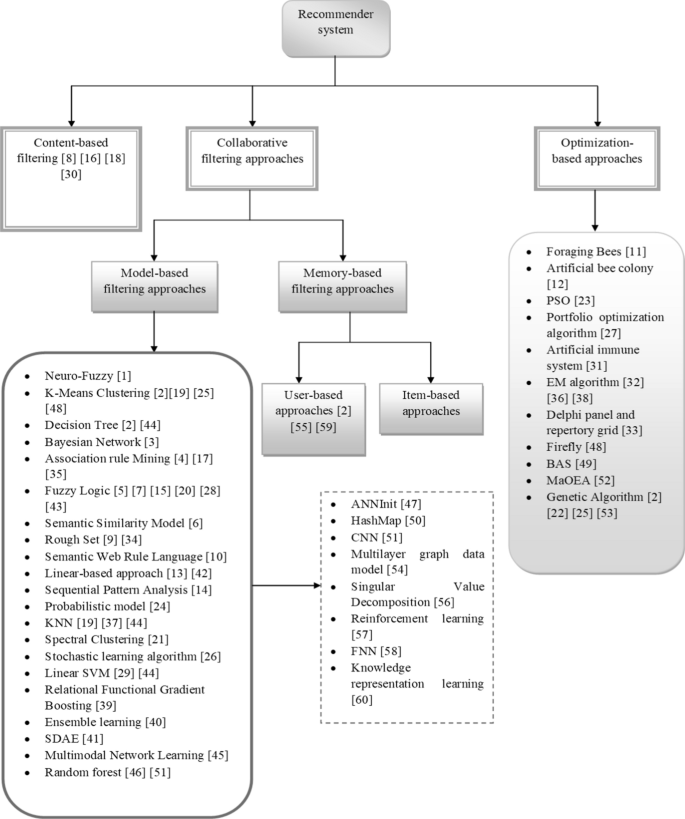
Categorization is done based on content-based, collaborative filtering-based, and optimization-based approaches. In [8], a content-based filtering technique was employed for increasing the ability to trust other agents and for improving the exchange of information by trust degree. In [16], it was applied to enhance the quality of recommendations using the account attributes of the material. It achieved better performance concerning with F1-score, recall and precision. In [18], this technique was able to capture the implicit user feedback, increasing the overall accuracy of the proposed model. The content-based filtering in [30] was able to increase the accuracy and performance of a stock recommender system by using the “trust factor” for making decisions.
Different collaborative filtering approaches are utilized in recent studies, which are categorized as follows:
Neuro-Fuzzy [1] based technique helps in discovering the association between user categories and item relevance. It is also simple to understand. K-Means Clustering [2, 19, 25, 48] is efficient for large scale datasets. It is simple to implement and gives a fast convergence rate. It also offers automatic recovery from failures. The decision tree [2, 44] technique is easy to interpret. It can be used for solving the classic regression and classification problems in recommender systems. Bayesian Network [3] is a probabilistic technique used to solve classification challenges. It is based on the theory of Bayes theorem and conditional probability. Association Rule Mining (ARM) techniques [4, 17, 35] extract rules for projecting the occurrence of an item by considering the existence of other items in a transaction. This method uses the association rules to create a more suitable representation of data and helps in increasing the model performance and storage efficiency. Fuzzy Logic [5, 7, 15, 20, 28, 43] techniques use a set of flexible rules. It focuses on solving complex real-time problems having an inaccurate spectrum of data. This technique provides scalability and helps in increasing the overall model performance for recommender systems. The semantic similarity [6] technique is used for describing a topological similarity to define the distance among the concepts and terms through ontologies. It measures the similarity information for increasing the efficiency of recommender systems. Rough set [9, 34] techniques use probability distributions for solving the challenges of existing recommender models. Semantic web rule language [10] can efficiently extract the dataset features and increase the model efficiency. Linear programming-based approaches [13, 42] are employed for achieving quality decision making in recommender models. Sequential pattern analysis [14] is applied to find suitable patterns among data items. This helps in increasing model efficiency. The probabilistic model [24] is a famous tool to handle uncertainty in risk computations and performance assessment. It offers better decision-making capabilities. K-nearest neighbours (KNN) [19, 37, 44] technique provides faster computation time, simplicity and ease of interpretation. They are good for classification and regression-based problems and offers more accuracy. Spectral clustering [21] is also called graph clustering or similarity-based clustering, which mainly focuses on reducing the space dimensionality in identifying the dataset items. Stochastic learning algorithm [26] solves the real-time challenges of recommender systems. Linear SVM [29, 44] efficiently solves the high dimensional problems related to recommender systems. It is a memory-efficient method and works well with a large number of samples having relative separation among the classes. This method has been shown to perform well even when new or unfamiliar data is added. Relational Functional Gradient Boosting [39] technique efficiently works on the relational dependency of data, which is useful for statical relational learning for collaborative-based recommender systems. Ensemble learning [40] combines the forecast of two or more models and aims to achieve better performance than any of the single contributing models. It also helps in reducing overfitting problems, which are common in recommender systems.
SDAE [41] is used for learning the non-linear transformations with different filters for finding suitable data. This aids in increasing the performance of recommender models. Multimodal network learning [45] is efficient for multi-modal data, representing a combined representation of diverse modalities. Random forest [46, 51] is a commonly used approach in comparison with other classifiers. It has been shown to increase accuracy when handling big data. This technique is a collection of decision trees to minimize variance through training on diverse data samples. ANNInit [47] is a type of artificial neural network-based technique that has the capability of self-learning and generating efficient results. It is independent of the data type and can learn data patterns automatically. HashMap [50] gives faster access to elements owing to the hashing methodology, which decreases the data processing time and increases the performance of the system. CNN [51] technique can automatically fetch the significant features of a dataset without any supervision. It is a computationally efficient method and provides accurate recommendations. This technique is also simple and fast for implementation. Multilayer graph data model [54] is efficient for real-time applications and minimizes the access time through mapping the correlation as edges among nodes and provides superior performance. Singular Value Decomposition [56] can simplify the input data and increase the efficiency of recommendations by eliminating the noise present in data. Reinforcement learning [57] is efficient for practical scenarios of recommender systems having large data sizes. It is capable of boosting the model performance by increasing the model accuracy even for large scale datasets. FNN [58] is one of the artificial neural network techniques which can learn non-linear and complex relationships between items. It has demonstrated a good performance increase when employed in different recommender systems. Knowledge representation learning [60] systems aim to simplify the model development process by increasing the acquisition efficiency, inferential efficiency, inferential adequacy and representation adequacy. User-based approaches [2, 55, 59] specialize in detecting user-related meta-data which is employed to increase the overall model performance. This technique is more suitable for real-time applications where it can capture user feedback and use it to increase the user experience.
The Foraging Bees [11] technique enables both functional and combinational optimization for random searching in recommender models. Artificial bee colony [12] is a swarm-based meta-heuristic technique that provides features like faster convergence rate, the ability to handle the objective with stochastic nature, ease for incorporating with other algorithms, usage of fewer control parameters, strong robustness, high flexibility and simplicity. Particle Swarm Optimization [23] is a computation optimization technique that offers better computational efficiency, robustness in control parameters, and is easy and simple to implement in recommender systems. Portfolio optimization algorithm [27] is a subclass of optimization algorithms that find its application in stock investment recommender systems. It works well in real-time and helps in the diversification of the portfolio for maximum profit. The artificial immune system [31]a is computationally intelligent machine learning technique. This technique can learn new patterns in the data and optimize the overall system parameters. Expectation maximization (EM) [32, 36, 38] is an iterative algorithm that guarantees the likelihood of finding the maximum parameters when the input variables are unknown. Delphi panel and repertory grid [33] offers efficient decision making by solving the dimensionality problem and data sparsity issues of recommender systems. The Firefly algorithm (FA) [48] provides fast results and increases recommendation efficiency. It is capable of reducing the number of iterations required to solve specific recommender problems. It also provides both local and global sets of solutions. Beetle Antennae Search (BAS) [49] offers superior search accuracy and maintains less time complexity that promotes the performance of recommendations. Many-objective evolutionary algorithm (MaOEA) [52] is applicable for real-time, multi-objective, search-related recommender systems. The introduction of a local search operator increases the convergence rate and gets suitable results. Genetic Algorithm (GA) [2, 22, 25, 53] based techniques are used to solve the multi-objective optimization problems of recommender systems. They employ probabilistic transition rules and have a simpler operation that provides better recommender performance.
The features and challenges of the existing recommender models are given in Table 6.
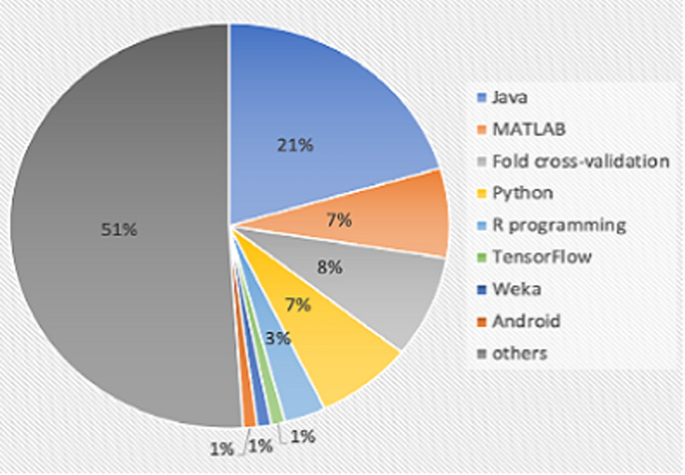
Here, the Java platform is used in 20% of the contributions, MATLAB is implemented in 7% of the contributions, different fold cross-validation are used in 8% of the contributions, 7% of the contributions are utilized by the python platform, 3% of the contributions employ R-programming and 1% of the contributions are developed by Tensorflow, Weka and Android environments respectively. Other simulation platforms like Facebook, web UI (User Interface), real-time environments, etc. are used in 50% of the contributions. Table 7 describes some simulation platforms commonly used for developing recommender systems.
Table 7 Common simulation platforms and their related informationThis section provides an analysis of the different applications focused on a set of recent recommender systems and their dataset details.
Recent recommender systems were analysed and found that 11% of the contributions are focused on the domain of healthcare, 10% of the contributions are on movie recommender systems, 5% of the contributions come from music recommender systems, 6% of the contributions are focused on e-learning recommender systems, 8% of the contributions are used for online product recommender systems, 3% of the contributions are focused on book recommendations and 1% of the contributions are focused on Job and knowledge management recommender systems. 5% of the contributions concentrated on social network recommender systems, 10% of the contributions are focused on tourist and hotels recommender systems, 6% of the contributions are employed for stock recommender systems, and 3% of the contributions contributed for video recommender systems. The remaining 12% of contributions are miscellaneous recommender systems like Twitter, venue-based recommender systems, etc. Similarly, different datasets are gathered for recommender systems based on their application types. A detailed description is provided in Table 8.
Table 8 Application focused and dataset description in different recommender systemsThe performance evaluation metrics used for the analysis of different recommender systems is depicted in Table 9. From the set of research works, 35% of the works use recall measure, 16% of the works employ Mean Absolute Error (MAE), 11% of the works take Root Mean Square Error (RMSE), 41% of the papers consider precision, 30% of the contributions analyse F1-measure, 31% of the works apply accuracy and 6% of the works employ coverage measure to validate the performance of the recommender systems. Moreover, some additional measures are also considered for validating the performance in a few applications.
Table 9 Performance analysis of different recommender systemsIn the recent decade, recommender systems have performed well in solving the problem of information overload and has become the more appropriate tool for multiple areas such as psychology, mathematics, computer science, etc. [80]. However, current recommender systems face a variety of challenges which are stated as follows, and discussed below:
Numerous recommender algorithms have been proposed on novel emerging dimensions which focus on addressing the existing limitations of recommender systems. A good recommender system must increase the recommendation quality based on user preferences. However, a specific recommender algorithm is not always guaranteed to perform equally for different applications. This encourages the possibility of employing different recommender algorithms for different applications, which brings along a lot of challenges. There is a need for more research to alleviate these challenges. Also, there is a large scope of research in recommender applications that incorporate information from different interactive online sites like Facebook, Twitter, shopping sites, etc. Some other areas for emerging research may be in the fields of knowledge-based recommender systems, methods for seamlessly processing implicit user data and handling real-time user feedback to recommend items in a dynamic environment.
Some of the other research areas like deep learning-based recommender systems, demographic filtering, group recommenders, cross-domain techniques for recommender systems, and dimensionality reduction techniques are also further required to be studied [83]. Deep learning-based recommender systems have recently gained much popularity. Future research areas in this field can integrate the well-performing deep learning models with new variants of hybrid meta-heuristic approaches.
During this review, it was observed that even though recent recommender systems have demonstrated good performance, there is no single standardized criteria or method which could be used to evaluate the performance of all recommender systems. System performance is generally measured by different evaluation matrices which makes it difficult to compare. The application of recommender systems in real-time applications is growing. User satisfaction and personalization play a very important role in the success of such recommender systems. There is a need for some new evaluation criteria which can evaluate the level of user satisfaction in real-time. New research should focus on capturing real-time user feedback and use the information to change the recommendation process accordingly. This will aid in increasing the quality of recommendations.
Recommender systems have attracted the attention of researchers and academicians. In this paper, we have identified and prudently reviewed research papers on recommender systems focusing on diverse applications, which were published between 2011 and 2021. This review has gathered diverse details like different application fields, techniques used, simulation tools used, diverse applications focused, performance metrics, datasets used, system features, and challenges of different recommender systems. Further, the research gaps and challenges were put forward to explore the future research perspective on recommender systems. Overall, this paper provides a comprehensive understanding of the trend of recommender systems-related research and to provides researchers with insight and future direction on recommender systems. The results of this study have several practical and significant implications:
This research will provide a guideline for future research in the domain of recommender systems. However, this research has some limitations. Firstly, due to the limited amount of manpower and time, we have only reviewed papers published in journals focusing on computer science, management and medicine. Secondly, we have reviewed only English papers. New research may extend this study to cover other journals and non-English papers. Finally, this review was conducted based on a search on only six descriptors: “Recommender systems”, “Recommendation systems”, “Movie Recommend*”, “Music Recommend*”, “Personalized Recommend*” and “Hybrid Recommend*”. Research papers that did not include these keywords were not considered. Future research can include adding some additional descriptors and keywords for searching. This will allow extending the research to cover more diverse articles on recommender systems.
We thank our colleagues from Assam Down Town University who provided insight and expertise that greatly assisted this research, although they may not agree with all the interpretations and conclusions of this paper.